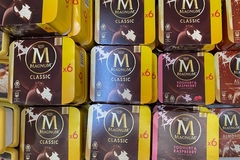
- Industry news
Industry news
- Category news
Category news
- Reports
- Key trends
- Multimedia
- Journal
- Events
- Suppliers
- Home
- Industry news
Industry news
- Category news
Category news
- Reports
- Key trends
- Multimedia
- Events
- Suppliers
Opportunities to make more “complex layered flavors” puts kokumi in spotlight, says PepsiCo R&D chef
23 Jan 2023 --- Spice inspired by global and regional cuisines are a key area of focus for PepsiCo, as well as ingredients that bring umami-type flavors, such as the new kid on the block: kokumi. Patrick Clifford, PepsiCo’s principal R&D chef, speaks to FoodIngredientsFirst about the trends he sees in restaurants, from street food to haute cuisine.
The company is also tapping into the latest food trends by examining what consumers are eating using AI-based analytics. According to Clifford, these methods “can uncover the next big flavors in snacks or beverages.”

“Our R&D team does not simply work on things from a technical point of view and we are inspired to be creative and experimental, as well as to use data and technology to understand consumer preferences. Developing new flavors is quite a complex process, so we work very closely with consumers to understand what they like and then work out how we can integrate that into our food,” he tells us.
 Ingredients that bring “a wealth of taste components such as umami-rich products will remain in the spotlight,” says Clifford.It is also crucial to ensure that products are easy to consume and fit into people’s lifestyles, underscores Clifford. “There is a huge amount of choice in F&B, so we must produce products that consumers want to repeatedly purchase. The average consumer may not jump onto the latest food trends – but it’s about choosing the right time to launch a new flavor and presenting it in the right way.”
Ingredients that bring “a wealth of taste components such as umami-rich products will remain in the spotlight,” says Clifford.It is also crucial to ensure that products are easy to consume and fit into people’s lifestyles, underscores Clifford. “There is a huge amount of choice in F&B, so we must produce products that consumers want to repeatedly purchase. The average consumer may not jump onto the latest food trends – but it’s about choosing the right time to launch a new flavor and presenting it in the right way.”
Umami and kokumi flavors rise
According to Clifford, any ingredients that bring “a wealth of taste components such as umami-rich products will remain in the spotlight.”
“The new kid on the block kokumi works in harmony with umami and is commonly described as more of a feeling in the mouth than a direct taste,” he details.
Kokumi provides roundness, richness and balance to other tastes.
Ramen, the Japanese noodle soup, is an excellent example of how kokumi is perceived as a sensation: warming, juicy, succulent and flavorsome.
“This has been on our radar for quite some time and will continue that way. As we dive deeper into authentic ingredients and recipes across multiple cultures and countries, we are expanding our understanding of new flavors – it’s a very exciting time to work in this area, but as you can imagine, lots of the work being undertaken must be kept secret.”
Experimenting with layered flavors
Individuals are looking for textures, ingredients, and flavors that are authentic to their culture and heritage and help them identify with what they are eating.
“Consumers are willing to experiment more than ever,” Clifford reflects. “They like their traditional and loved products, but they are always checking the shelves for innovation to incorporate into their repertoire.”
In terms of applications, PepsiCo typically works across all types of bases. According to Clifford, they all bring their own subtle complexities due to the ingredients and the cooking process.
“Potato chips, for example, can create different flavor notes depending on whether they are fried or baked. This must be taken into consideration when developing the flavor,” he outlines. Patrick Clifford, PepsiCo’s principal R&D chef, believes “food is a shared language spoken worldwide.” (Credit: PepsiCo)
“A baked chip tends to be slightly drier, so we may look to bring back some of the juicy, succulent characteristics you might associate with a fried potato, so there is minimal compromise on flavor and texture. The more neutral the flavor of the base snack, the more opportunity there is to create more complex layered flavors.”
Dreaming up new and effective concepts
AI-based analytics allows PepsiCo to delve into consumer preferences and mine data to dream up new flavors and insights. This helps the company predict market demand and ensure its marketing campaigns are relevant to consumers.
“This means we can tap into the trends that affect our brands and the people who buy them now – and in years to come,” adds Clifford.
“Of course, taste is essential when it comes to our products at PepsiCo. The guarantee of familiar, delicious flavors that complement the textural differences of our snacks is what keeps consumers coming back for more. “
PepsiCo is always looking for what’s next for its consumers. “We’re constantly innovating in new areas, reformulating our recipes and looking for ways to improve their nutritional content using high-quality ingredients and new technologies,” flags Clifford.
He expresses that “food is a shared language spoken worldwide.”
Traveling, absorbing yourself in the local culture and experiencing new and traditional things is one of the most interesting parts of Clifford’s job, he adds.
Targeting wellness post-COVID-19
Since the pandemic, another key trend that PepsiCo has noted is that consumers are looking for healthier choices, leading R&D teams to find ways to improve the nutritional profile of its brands.
“As part of PepsiCo’s commitments, we are reformulating products to provide consumers with more positive choices that are lower in saturated fats, salt and sugar, kinder to the planet and never compromise on taste,” Clifford notes.
“Wellness has seen a boost in line with this,” he explains. “Reduced stress, better sleep, calming and improved mood are all very beneficial to our consumers across all markets, and the desire for functional benefits continues to rise.”
 PepsiCo is tapping into the latest food trends by examining what consumers are eating using AI-based analytics.For example, people are looking for beverages to help soothe frayed nerves and are turning toward relaxing ingredients such as lavender, chamomile and lemon.
PepsiCo is tapping into the latest food trends by examining what consumers are eating using AI-based analytics.For example, people are looking for beverages to help soothe frayed nerves and are turning toward relaxing ingredients such as lavender, chamomile and lemon.
“In our product portfolio, we have also introduced more functional ingredients into our products, like the Panax ginseng in soul boost lift,” he concludes.
Sustainable pathways
F&B giants are rallying on policies to restore the earth and reduce carbon emissions. Producing climate-friendly food is the future.
Businesses realize that investing in regenerative farming practices will pay off now and in the years ahead as consumers demand even more from brands in terms of planet-friendly offerings.
In September, ADM and PepsiCo joined forces on carbon-friendly agricultural practices to reduce carbon intensity.
Meanwhile, PepsiCo revealed last August that it is on track to elevate its supply chain in Europe and collaborate with start-ups to pilot new technologies which will boost environmentally sustainable solutions.
Six start-ups were selected through a program that engages the start-up community to bring emerging technologies to the fore.
PepsiCo aims to scale the successful technologies across the supply chain during 2023 and beyond.
To bolster access to renewable electricity across its value chain, PepsiCo and Schneider Electric also launched pep+ REnew as part of PepsiCo’s pep+ (PepsiCo Positive) transformation program. The initiative will help companies achieve net-zero emissions by 2040.
By Elizabeth Green











